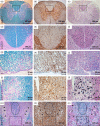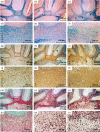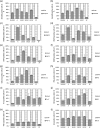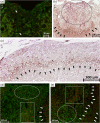The formation of a glial scar does not prohibit remyelination in an animal model of multiple sclerosis
- PMID: 30484905
- PMCID: PMC6588096
- DOI: 10.1002/glia.23556
The formation of a glial scar does not prohibit remyelination in an animal model of multiple sclerosis
Abstract
The role of astrocytes in the pathophysiology of multiple sclerosis (MS) is discussed controversially. Especially the formation of the glial scar is often believed to act as a barrier for remyelination. At the same time, astrocytes are known to produce factors that influence oligodendrocyte precursor cell (OPC) survival. To explore these mechanisms, we investigated the astrocytic reaction in an animal model induced by immunization with myelin oligodendrocyte glycoprotein (MOG) in Dark Agouti (DA) rats, which mimics most of the histological features of MS. We correlated the astroglial reaction by immunohistochemistry (IHC) for glial fibrillary acidic protein (GFAP) to the remyelination capacity by in situ hybridization for mRNA of proteolipid protein (PLP), indicative of OPCs, over the full course of the disease. PLP mRNA peaked in early remyelinating lesions while the amount of GFAP positive astrocytes was highest in remyelinated lesions. In shadow plaques, we found at the same time all features of a glial scar and numbers of OPCs and mature oligodendrocytes, which were nearly equal to that in unaffected white matter areas. To assess the plaque environment, we furthermore quantitatively analyzed factors expressed by astrocytes previously suggested to influence remyelination. From our data, we conclude that remyelination occurs despite an abundant glial reaction in this animal model. The different patterns of astrocytic factors and the occurrence of different astrocytic phenotypes during lesion evolution furthermore indicate a finely regulated, balanced astrocytic involvement leading to successful repair.
Keywords: astrocytes; glial scar; multiple sclerosis; oligodendrocyte precursor cells; remyelination; shadow plaque.
© 2018 The Authors. Glia published by Wiley Periodicals, Inc.
Conflict of interest statement
The authors declare no conflicts of interest.
Figures






Similar articles
-
The response of NG2-expressing oligodendrocyte progenitors to demyelination in MOG-EAE and MS.J Neurocytol. 2002 Jul-Aug;31(6-7):523-36. doi: 10.1023/a:1025747832215. J Neurocytol. 2002. PMID: 14501221
-
Induction of oligodendrocyte proliferation and remyelination after chronic demyelination. Relevance to multiple sclerosis.Lab Invest. 1988 Oct;59(4):467-76. Lab Invest. 1988. PMID: 2459499
-
Microglial and astroglial reactions to inflammatory lesions of experimental autoimmune encephalomyelitis in the rat central nervous system.J Neuroimmunol. 1992 Mar;37(1-2):23-33. doi: 10.1016/0165-5728(92)90152-b. J Neuroimmunol. 1992. PMID: 1372328
-
Oligodendrocyte Progenitors in Glial Scar: A Bet on Remyelination.Cells. 2024 Jun 12;13(12):1024. doi: 10.3390/cells13121024. Cells. 2024. PMID: 38920654 Free PMC article. Review.
-
Multiple Sclerosis: Basic and Clinical.Adv Neurobiol. 2017;15:211-252. doi: 10.1007/978-3-319-57193-5_8. Adv Neurobiol. 2017. PMID: 28674983 Review.
Cited by
-
Cross-Talk of the CNS With Immune Cells and Functions in Health and Disease.Front Neurol. 2021 May 31;12:672455. doi: 10.3389/fneur.2021.672455. eCollection 2021. Front Neurol. 2021. PMID: 34135852 Free PMC article. Review.
-
Piperine Improves Experimental Autoimmune Encephalomyelitis (EAE) in Lewis Rats Through its Neuroprotective, Anti-inflammatory, and Antioxidant Effects.Mol Neurobiol. 2021 Nov;58(11):5473-5493. doi: 10.1007/s12035-021-02497-5. Epub 2021 Aug 2. Mol Neurobiol. 2021. PMID: 34338970
-
Microglia depletion as a therapeutic strategy: friend or foe in multiple sclerosis models?Neural Regen Res. 2023 Feb;18(2):267-272. doi: 10.4103/1673-5374.346538. Neural Regen Res. 2023. PMID: 35900401 Free PMC article. Review.
-
Microglia dynamic response and phenotype heterogeneity in neural regeneration following hypoxic-ischemic brain injury.Front Immunol. 2023 Nov 29;14:1320271. doi: 10.3389/fimmu.2023.1320271. eCollection 2023. Front Immunol. 2023. PMID: 38094292 Free PMC article. Review.
-
Neuromodulation of Glial Function During Neurodegeneration.Front Cell Neurosci. 2020 Aug 21;14:278. doi: 10.3389/fncel.2020.00278. eCollection 2020. Front Cell Neurosci. 2020. PMID: 32973460 Free PMC article.
References
-
- Back, S. A. , Tuohy, T. M. F. , Chen, H. , Wallingford, N. , Craig, A. , Struve, J. , … Sherman, L. S. (2005). Hyaluronan accumulates in demyelinated lesions and inhibits oligodendrocyte progenitor maturation. Nature Medicine, 11, 966–972. - PubMed
-
- Bauer J, Bradl M, Klein M, Leisser M, Deckwerth TL, Wekerle H, Lassmann H. 2002. Endoplasmic reticulum stress in PLP‐overexpressing transgenic rats: Gray matter oligodendrocytes are more vulnerable than white matter oligodendrocytes. The Journal of Neuropathology & Experimental Neurology 61:12–22. Available from: http://www.ncbi.nlm.nih.gov/htbin‐post/Entrez/query?db=m&form=6&dopt=r&u... - PubMed
-
- Brambilla, R. , Morton, P. D. , Ashbaugh, J. J. , Karmally, S. , Lambertsen, K. L. , & Bethea, J. R. (2014). Astrocytes play a key role in EAE pathophysiology by orchestrating in the CNS the inflammatory response of resident and peripheral immune cells and by suppressing remyelination. Glia, 62, 452–467. - PubMed
MeSH terms
LinkOut - more resources
Full Text Sources
Research Materials
Miscellaneous

